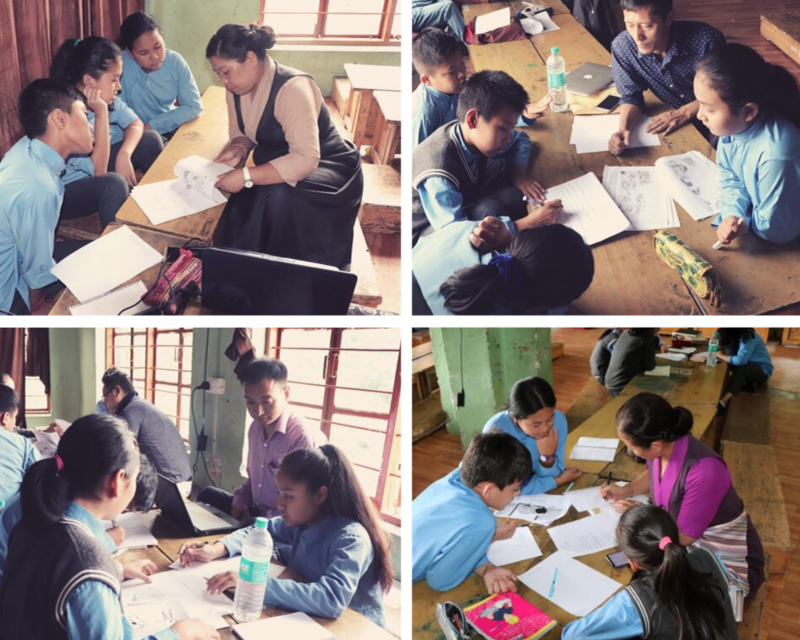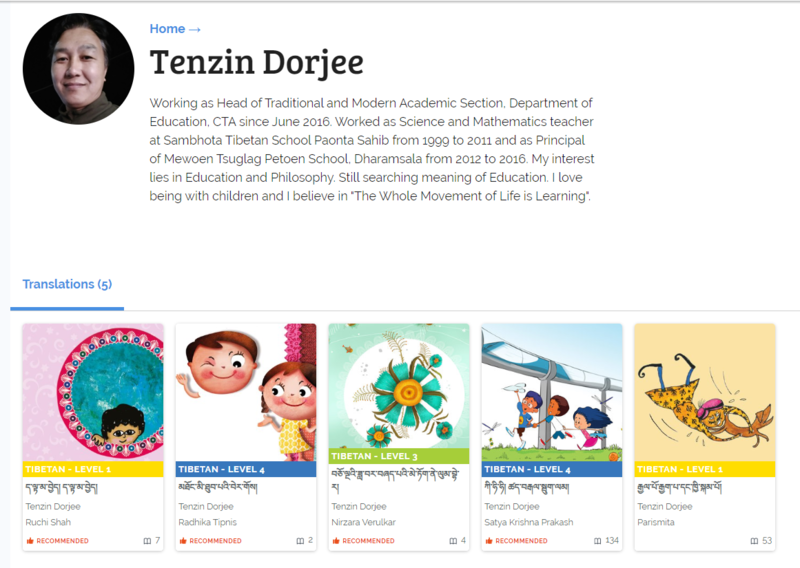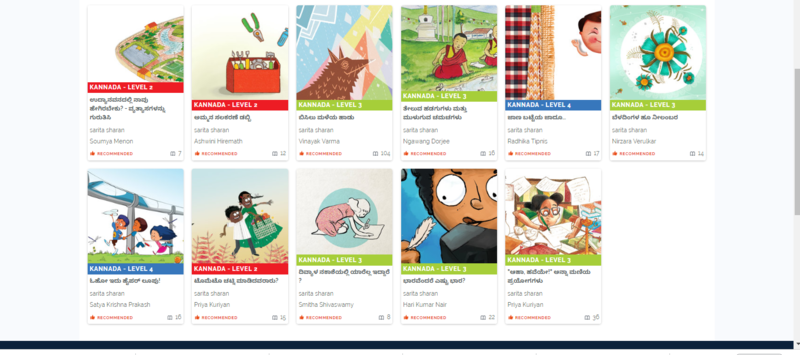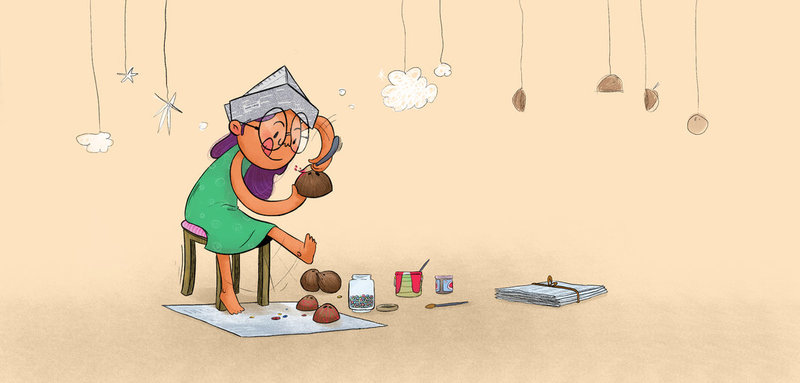Bringing more Tibetan storybooks to children
Posted by Remya Padmadas on October 04, 2019Tenzin Choedon is a teacher, who is presently working as the headmistress at Mewoen Tsuglag Petoen School run by Sambhota Tibetan Schools Society under the Department of Education, CTA, Dharamsala. She loves reading and writing poetry. Her husband, Tenzin Dorjee has been working as the head of Traditional and Modern Academic Section, Department of Education, CTA since June 2016.
In this blog post, the husband-wife duo write about being part of a translation sprint to translate storybooks into Tibetan for Pratham Books.
Our relation with Pratham Books had been really wonderful and we owe this to MES (Manjushri Educational Services) for providing us the opportunity to translate 5 of their STEM stories. Our relation became stronger later after the interactive session we had in the Tibet Fund office at Mcleod Ganj followed by another informal meeting at Dhauladhar, Dharamshala. Just recently we translated four of the stories on the theme 'Water' for Pratham Books. We are grateful to the Pratham Books team for believing in us for this important translation work.
On 3rd September, I along with five teachers and 25 students from our school had the opportunity to be part of a translation sprint during which we translated a total of 15 level 1 storybooks from Pratham Books with Mr. Buddha Kyab and Mr. Ngawang Tsetan (MES Team members). It was a wonderful experience.

Pictures from the Tibetan translation sprint conducted by MES with teachers and students of Piteon school in Dharamshala.
Before being part of the translation team for the translation of STEM stories into Tibetan language, my husband and I had no experience of translating stories. Only after being involved in the translation work, many facts about translation work gradually unfolded for us. The translation of children storybooks may appear to be easy one for those who are not involved in the process but our past experiences had made one thing very clear - writing and translating children stories is not at all an easy task. It requires a lot of thoughtful considerations and patience to draft, reread, review and edit the story at your end as the translator before making the final draft to be reviewed by the reviewing team.
The most difficult part in translating a story from English to another language is deciding on a child-friendly language which does not affect the grammatical structure of the language or the flavour of the story. The most challenging part is the time you have to devote for the translation work but if you are interested then you will be able to meet this challenge happily. Moreover, to be able to do well in translating children stories one has to have a good understanding of children's language and their taste.

Stories translated by Tenzin Dorjee into Tibetan
Being a part of the translation team for STEM stories and our experience thereafter with Pratham Books had really changed our outlook towards children literature besides giving us a very rich learning experience. We are highly indebted and grateful to everyone involved in our journey as translators (beginners), though not full fledged. We are also grateful to our daughters for reading each of our translated stories as a trial for further changes before our final drafts, on behalf of the rest of the children. Their reading of the stories reflect their understanding, and this has been really very helpful in making the necessary changes that we as adults might have failed to see.
We thank Pratham Books for this wonderful initiative and for your contribution towards Children Literature. Lastly, we wish the whole team of Pratham Books a very Happy Translation Day!
We would love for you to join the conversation by leaving your thoughts in the comments section, or on social media: Facebook, Twitter, Instagram.
Be the first to comment.StoryWeaver Spotlight: Sarita Sharan
Posted by Amna Singh on September 28, 2018StoryWeaver Spotlight aims to shine the light on members of the wonderful community of translators who help bring stories alive in new languages through their translation efforts. This week, we turn the spotlight on Sarita Sharan. Sarita is a passionate teacher, who uses stories to pass on information in a fun way to her students and her two kids. She works at a primary school in Badami Taluk, Bagalakot district. She often visits underserved communities and strives to convince drop-outs to continue schooling. Science, English and Maths are her favorite subjects. She has translated 11 books to Kannada for Pratham Books including Whpopee Hyperloop, Neelumbera on a Full Moon Night and Anna's Extraordinary Experiments with Weather.

Q: What type of person do you think makes the best translator for children’s stories?
A: Someone who works closely with children: teachers and storytellers, for example.
Q: Do you have any advice for anyone interested in becoming a translator?
A: If you can revisit your childhood and think and narrate like a child you are almost half way towards becoming a translator.
Q: A Book you'd like to recommend to other translators?
I don’t see any set rules for this, it really depends on each piece of work and the way you want to communicate. For me, reading updated STEM curriculum, boosts my efficiency.
Q: What is your personal relationship to language and/or translation?
A: It is just like the relationship between a student and a teacher. A language is so rich, so versatile, so essential to communication.
Q: When you’ve been given a story to translate, what’s your process, and how long does it generally take?
A: I read the whole story a couple of times. And, imagine narrating the same to my students before I begin. How long? Ha ha! It depends on my schedule,
Q: What do stories in translation bring to young readers?
I think the highlight of translated stories is that they bring diversity, and introduce readers to different cultures and places. Kids really just enjoy the variety.
Q: You’ve translated stories for us. Which has been your favourite to work on?
I liked Neelambara on a Full Moon Night, Sailing Ships and Sinking Spoons, Who Made Tomato Chutney and the Annamani story. They were were my favourites. I really liked the concepts and the way they were told as stories.

Q: What is the hardest thing about translating from English into Kannada? How do you navigate words or phrases that are tricky to translate??
A: I think common sense quotient works here. It’s just about the concept as a whole and the way you narrate in your language. I think my profession has equally helped me in this regard.
Q: How do you feel when your story reaches the child?
Wow! That’s an amazing feeling. I feel like a student who’s waiting for results.
Q: Translating stories must have required research when it came to STEM related terms and concepts.. How did you explore new objects and concepts?
Like I said, I refer to the latest curriculum related to STEM concepts. So, it clears my confusion and difficulty while translating too.
Q: How else do you think we can join hands to take more stories to more children in more languages.
My wish is that we reach almost every school in every nook and corner as a group till books reach the last child. I personally prefer print formats for this , as the feel of a book is sacred.
Q: As a passionate teacher, story teller what do you think is the best way to approach a child?
Be a child while translating, narrating. That’s all!!
Be the first to comment.This is Ameena!
Posted by Remya Padmadas on September 27, 2017Almost seven weeks ago, we asked YOU the question “Who is Ameena?” and now, we have an answer!
The contest to find an illustrator for What is Ameena Up To?, a cheery story written by Roopa Banerjee, gave StoryWeaver a great collection of merry, adventurous, whimsical, curious girls. But the Ameena-est of them all was the character drawn by Preetam Dhar.

Having received over 50 fabulous entries, the task of selecting a winner was not easy. At the final stage, it was down to four contenders -- Sangeeta Das, Preetam Dhar, Rahil Mohsin and Alankrita Amaya -- who had all created splendid work.
But something about Preetam’s Ameena struck Vinayak Varma, the contest judge - “Preetam's Ameena looks friendly and approachable, but also slightly strange and quirky -- this is exactly the right mix of traits for an appealing children's book character. His illustration is very well drawn, shows detail without being overdone, and demonstrates good command of colour and composition.”
Preetam’s understanding of the crux of the story and the character is clear from his vision note, where he says, “Aspirations bigger than her size and gleam of curiosity in her eyes -- that's Ameena for you. She's the girl who lives an ordinary life like you and me, made extraordinary by her imagination and inquisitiveness.”
We’ll all be able to see Preetam’s take on the story in a few months, because winning this contest has earned him a paid contract with Pratham Books!
Thank you to everyone who participated in the contest. Keep an eye out for how your delightful illustrations are being used by our community on StoryWeaver!
Be the first to comment.